Below, you’ll find our Energy Consumption Calculator, which helps you estimate your energy consumption in both Watt-hours (Wh) and kiloWatt-hours (kWh) based on:
- The appliances you use.
- Their Power Usage (in Watts).
- Their daily usage duration (in hours).
- The number of days in which you use each appliance.
Below the calculator, I provide some instructions on how to use the tool properly, as well as an example.
For those of you who are interested, I’ll also discuss Electricity measurement units such as Watts (W) or kiloWatts (kW) and Watt-hours (Wh) or kiloWatt-hours (kWh), the difference between these units, and how the electricity consumption of an appliance can be calculated.
Energy Consumption Calculator
The Energy Consumption Calculator allows you to list all of your appliances, calculate the energy consumption of each appliance in Watt-hours (Wh), and calculate your total energy consumption in Watt-hours (Wh) or kiloWatt-hours (kWh).
The calculator has 4 inputs:
Appliance:
The calculator provides a list of common appliances that you can choose from. If your appliance is not included in the drop-down menu, simply type the name of the appliance.
Power Usage (Watts):
Here, enter the Wattage or the Power Usage (in Watts) of the appliance.
In the “Appliance” input, if you click on, and choose an appliance from the drop-down menu, the calculator will provide an estimate of the power usage (Wattage) for that appliance, which you can modify if you know the exact power usage of the appliance.
If you’ve entered an appliance that’s not in the drop-down menu, make sure to enter the power rating of the appliance (in Watts).
The power rating of the appliance is usually found in the nameplate on the back, side, or bottom of the appliance, and is indicated in “Watts”. (more on this below)
Daily Usage Duration (hours):
Here, simply enter the amount of time (in hours) for which you use the appliance each day. For example, if your appliance is a desktop computer, that you use for 6 hours a day, enter 6.
If your appliance is a freezer or a refrigerator, that is plugged in 100% of the time (24 hours a day), enter 24.
Some appliances only need to be used for a few minutes, so, to figure out the usage duration of one of these appliances in hours, simply divide the usage duration (in minutes) by 60:
Usage Duration (in hours) = Usage Duration (in minutes) ÷ 60
For example, let’s say that one of your appliances is an electric kettle, which you use twice a day.
Electric kettles will usually require around 3 minutes to boil the water. If used twice a day, the daily usage duration of the kettle is 6 minutes. The daily usage duration of the kettle in hours is then:
Usage Duration (in hours) = Usage Duration (in minutes) ÷ 60
Usage Duration (in hours) = 6 ÷ 60
Usage Duration (in hours) = 0.1 hours
6 minutes is equivalent to 0.1 hours.
The number of days:
This is simply the number of days for which the appliance is going to be used.
Once you’re done with a particular appliance, you can add other appliances to the list by clicking on the “+” button. You can also click on the “-” button to remove an appliance.
Before I provide an example, let’s go over some electricity usage calculation basics.
How to calculate the electricity usage of an appliance?
The most common electrical specifications that you would find on an appliance’s nameplate are:
Voltage (Potential):
The Voltage rating on an appliance represents the Electric Potential difference at which the appliance operates. Voltage is typically represented by the symbol “V” and is measured in units of “Volts” (simply V).
Most appliances in the U.S., that use Alternating Current (AC), such as refrigerators, water heaters, and split air conditioners, operate at a nominal Voltage of 120 Volts (120 VAC), which is the voltage provided in your common household wall outlet.
Whereas most of the rest of the world runs their appliances on a nominal Voltage of 220 Volts (220 VAC).
Appliances that use Direct Current (DC), such as car cigarette lighters, and portable refrigerators, operate at a nominal Voltage of 12 Volts (12 VDC).
Amperage (Current):
The Amperage rating on an appliance represents the amount of Electric Current that the appliance uses. Electric Current is typically represented by the symbol “I” and is measured in units of “Amperes” (simply “Amps” or “A”).
Depending on what its function is, a household appliance could draw anywhere from 0.1 Amps to 100 Amps (or even more).
Wattage (Power):
The Wattage rating on an appliance represents the amount of Electric Power that the appliance uses. Electric Power is typically represented by the symbol “P” and is measured in units of “Watts” (or simply “W”).
When trying to determine the amount of electricity that an appliance uses, the Power (Wattage) rating of the appliance is its most important rating. Before I explain why that is, let me first discuss the relationship between these ratings.
The relationship between Voltage, Current, and Power:
Electric Power (in Watts) is the product of the Electric Current (in Amps) that the appliance uses and the Voltage (in Volts) that drives that current. This relationship between Current, Voltage, and Power, can be represented as such:
Power (Watts) = Voltage (Volts) x Amperage (Amps)
For example, consider a light bulb that is plugged into the typical wall outlet in an American home. As mentioned above, wall outlets in the U.S. provide a Voltage of about 120 Volts (120 VAC).
If the light bulb draws 0.5 Amps of current, its Power usage can be calculated as such:
Power (Watts) = Voltage (Volts) x Amperage (Amps)
Power (Watts) = 120 Volts x 0.5 Amps
Power (Watts) = 60 Watts
Now, consider an LED light that uses 12 Volts (12 VDC). If our LED light is rated at 2 Amps, its Power usage is:
Power (Watts) = 12 Volts x 2 Amps
Power (Watts) = 24 Watts
Click here to learn more about Amps, volts, and Watts.
Now that we’ve got that covered, let’s discuss what really matters: Electrical Energy.
How to calculate the Energy Usage of an appliance?
When trying to quantify the electricity usage of an appliance, what you’re really trying to determine is the amount of Electrical Energy that the appliance uses over a certain period of runtime.
Electrical Energy is measured in Watt-hours (Wh), or more commonly kilo watts-hours (kWh), with 1 kWh equal to 1000 Wh (1 kWh = 1000 Wh).
When your utility company charges you, they mainly charge you based on how many kiloWatt-hours (kWh) you’ve used during your billing period. So, what you pay for, and what really matters, is not the Voltage (Volts), Current (Amps), or Power (Watts) that your appliances use, but the Energy (Watt-hours or kiloWatt-hours) they’ve consumed.
Although they are often confused, Electrical Power (Watts) and Electrical Energy (Watt-hours) are not the same. So, what is the difference between them?
While Electrical Energy (Wh) is accumulative and represents the quantity, if you will, of electricity that has been consumed, generated, or transferred in general, Electrical Power (W) is instantaneous and represents the rate at which that Energy is being transferred.
Read more about this here: The difference between kW and kWh
Since Power represents the rate at which Energy is being transferred, the relationship between Power and Energy can be represented as such:
Energy (in Watt-hours) = Power (in Watts) x Time (hours)
For example, consider a light bulb that continuously uses 60 Watts of power. If the same light bulb is left on for 5 hours, the amount of energy that it would have consumed by the end of those 5 hours is:
Energy (in Watt-hours) = Power (in Watts) x Time (hours)
Energy (in Watt-hours) = 60 Watts x 5 hours
Energy (in Watt-hours) = 300 Watt-hours
Which is equivalent to 0.3 kiloWatt-hours (kWh).
In other words, if you know:
- The Power Usage of the appliance (in Watts), which is specified by the manufacturer, or if not, can be calculated using the Voltage (V) and Amperage (A) specifications of the appliance.
- And the usage duration of the appliance (in hours).
Using the formula above, for most appliances, you could easily calculate their energy consumption (in Watt-hours) over that duration.
But, why “for most appliances” and not for all of them?
Well, simply because for some appliances such as refrigerators, air conditioners, water heaters, and space heaters, the rate at which they consume energy, i.e. their power usage, doesn’t remain constant for 100% of their usage duration.
Let me explain.
For instance, consider a refrigerator that is rated at 150 Watts of power.
When the refrigerator is first plugged in and set to a certain temperature, it will use 150 Watts of power to lower the internal temperature until it reaches the set temperature. Once that set temperature is reached, the refrigerator’s job is now to maintain that temperature.
The refrigerator then maintains that temperature by turning ON and OFF. When the refrigerator is ON, it draws 150 Watts of power. When it’s OFF, it barely draws any power:
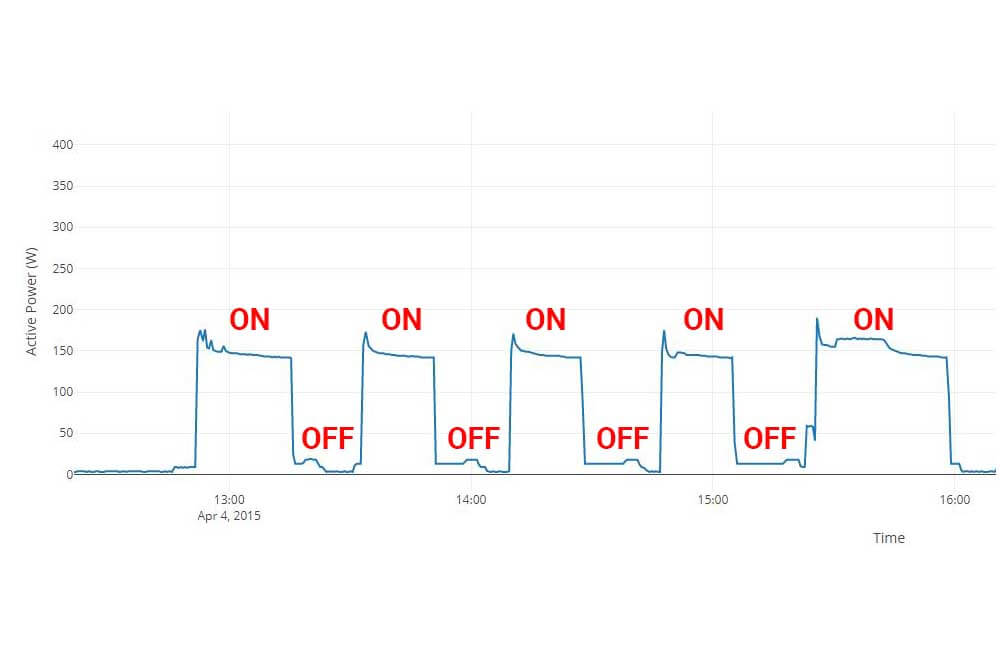
The percentage of time for which the refrigerator is actually running is called the Duty Cycle. If theoretically, we knew the duty cycle of the refrigerator, the Energy Consumption could be calculated as such:
Energy Consumption (Watt-hours) = Power Usage (Watts) x Usage Duration (hours) x Duty Cycle (%)
This is more or less the case for any appliance whose function is to change the temperature, may it be the temperature of water for water heaters or the temperature of the air for air conditioners, space heaters, refrigerators, and freezers.
However, since the duty cycle itself will depend on many factors such as the ambient temperature, the frequency of door openings, how full the refrigerator is, etc… when it comes to these calculations, the best we can do is use rules of thumb.
If you use the calculator above, you won’t have to worry about this, as it uses appropriate rules of thumb when calculating the energy consumption of these appliances. But make sure the appliance is selected from the drop-down menu.
Let’s look at an example.
Example:
For this example, let’s say I’m trying to calculate the battery capacity for a solar system that could run a few of my appliances.
As I explain in this article, the first step to determine the size of the battery bank that you need for an off-grid solar system is to determine the daily energy consumption of your appliances. Our Energy Consumption calculator helps you do just that.
These are the appliances:
- A 10 Cu. ft. refrigerator
- An 8 Cu. ft. chest freezer
- A 40″ TV
- An induction cooktop
- An electric kettle
- A laptop computer
- A phone
- 3 LED lights
- A tankless water heater
- A 5000 BTU air conditioner
For the rest of this example, I’ll assume that I don’t know what the power rating of each of these appliances is. So, I’ll just select the appliances from the dropdown menu in the “Appliance” input, and let the calculator estimate their power usage for me.
Also, since in this example, I’m trying to determine the daily energy consumption of my appliances, I’ll enter “1” in the “Number of days” input for all of these appliances.
Once I’m done with an appliance, I’ll simply click on the “+” button to add the next appliance to my list.
The refrigerator:
Refrigerators are left on 24 hours a day, so I’ll just enter “24” in the “Daily Usage Duration” input.
Here are the results for the refrigerator:
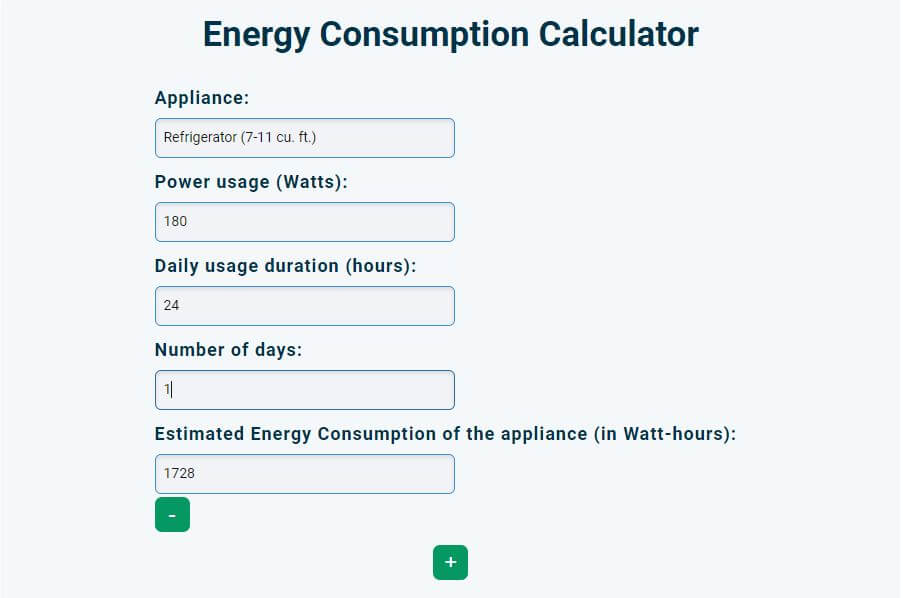
The calculator estimate that my 10 Cu. ft. refrigerator will consume 1728 Watt-hours (Wh) of energy on a daily basis.
The chest freezer:
Freezers are also plugged in 24 hours a day, so I’ll enter 24 as the daily usage duration of the freezer.
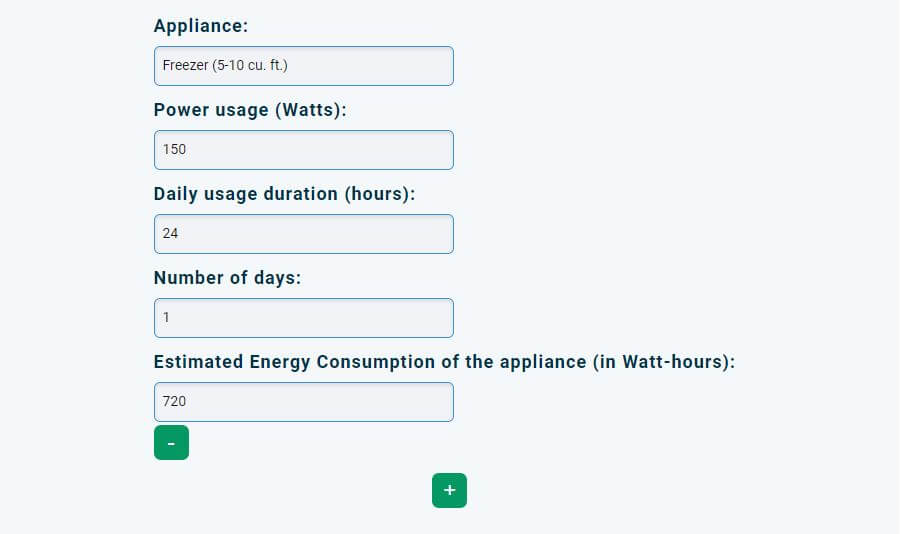
The calculator estimates that the chest freezer consumes about 720 Wh of energy per day.
The TV:
Assuming I watch TV for 4 hours a day, here are the results:
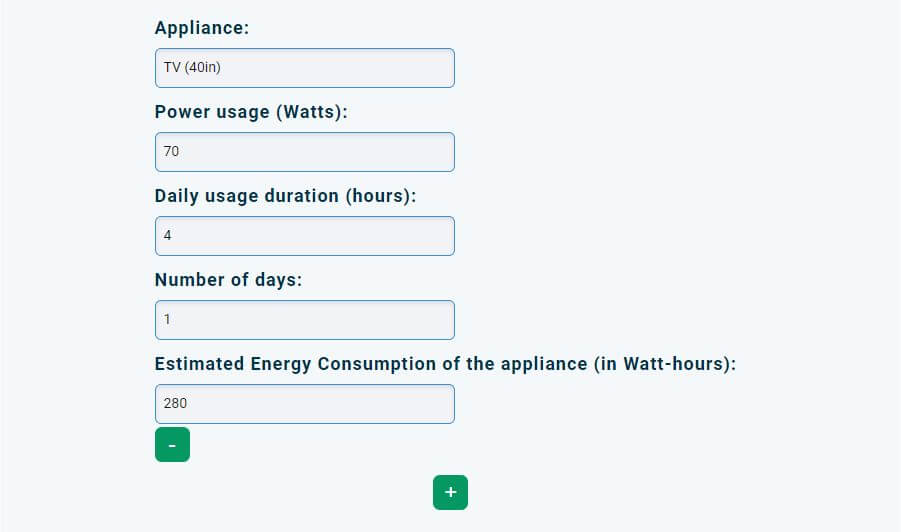
The induction cooktop:
Let’s say I only use the induction cooktop to cook breakfast. So, once a day, the cooktop has to run for about 10 minutes, which equates to about 0.17 hours (10 ÷ 60):
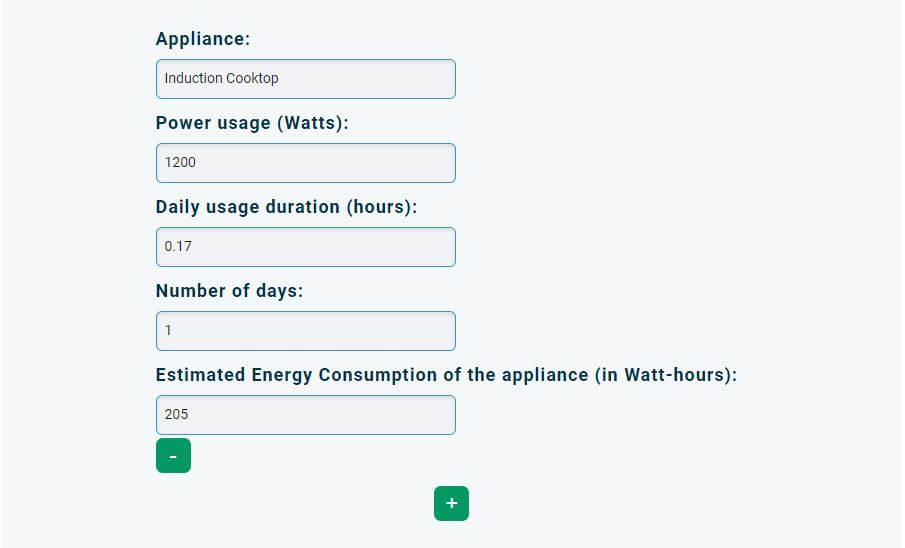
The kettle:
Let’s say I use my electric kettle twice a day, and each time I use it, it needs to run for about 3 minutes to boil the water. So that’s a total of 6 minutes a day, which equates to 0.1 hours (6 ÷ 60):
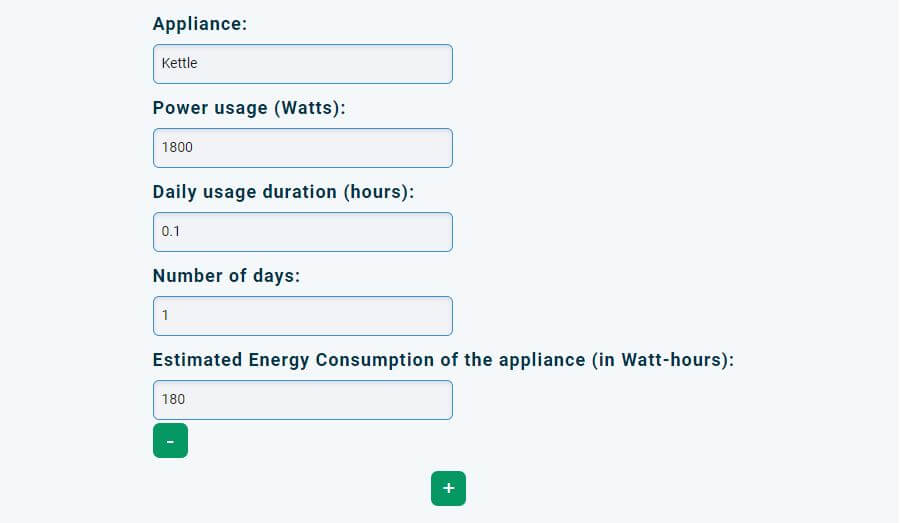
I continued adding the rest of the appliances, and at the bottom of the calculator, here are the results:

The calculator estimates that my appliances consume 7308 Watt-hours (Wh) of energy per day, which equates to about 7.3 kWh of energy.



I am extremely grateful for the expensive knowledge sharing. May you generously be blessed. I am trying to know how many batteries 200amp to be used in running a 1 HP Air conditioner (split), the capacity of the inverter to be used, and the number of panels required, to be used for 24 hrs daily. May your knowledge escalate to the highest level.
Hey there Mustapha,
You are very welcome.
Here’s a quick answer to your question: a 1HP air conditioner will on average use 0.4 kWh per hour of use. So, if it’s used for 24 hours a day, it should consume around 10 kWh of energy on a daily basis.
Depending on how much daily sunlight (Peak Sun Hours) is available in your area, you’ll probably need 2000-2500 Watts of solar (2-2.5 kW).
One 12V-200Ah battery has an energy capacity of 2.4 kWh. If these are Lithium batteries, and can be fully discharged, you’ll need around 4 or 5.
As to the inverter, you’ll probably need a 2 in one inverter (MPPT + inverter).
I recommend reading this article, as it explains everything you need to know on the energy consumption of a mini split air conditioner.
After you’re done with that, I suggest reading this article on sizing battery banks.
Then I recommend reading this article on sizing inverters for air conditioners.
Hope this helped.